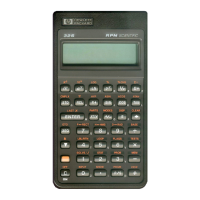Suppose the stack is filled with 1, 2, 3, 4 (press 11
enter
121
enter
13
I
enter
I4). Pressing |R*I four times rolls the numbers all the way
around and back to where they started:
T
1
LH]
4
EE
3
LrD
2
LIE
1
Z
2
1 4
3
2
Y
3
2
1 4 3
X
4 3 2
1 4
What was in the X-register rotates around and enters the T-register.
Notice that the
contents
of the registers are rolled. The registers them
selves maintain their positions,
and
the X-registeris always displayed.
Exchanging
the
X-
and
Y-Registers
in
the
Stack
Another key that manipulates the stack contents is |x$y|(x
exchange
y).
It swaps the contents of the X- and Y-registers without affecting the
rest of the stack. Pressing
|x*y|
twice,
of course, restores the original
order
of
the
contents.
The
|x$y[
function is used primarily for two purposes:
• To view y and then return it to the Y-regjster (press fxiyl twice).
Some functions yield two results: one into the X-register and one
into the Y-regjster. An exampleis {y,x*6,r
},
which converts rect
angular coordinates in the X-and Y-registers into polar coordinates
in the X- and Y-registers.
•
To
swap the order of numbers in a calculation. For example, an
easy way to calculate 9
•*•
(13 x 8) is to press 13 I
enter
I8
09
as.
2:
The
Automatic
Memory
Stack
37

